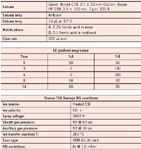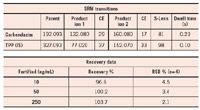Determination of Carbendazim in Orange Juice Using QuEChERS and LC/MS/MS
UCT Application Note
The planar fungicide carbendazim (CASRN 10605-21-7) can be used to control mold on citrus crops but is not approved for use in the US or on imported products. Concentrations in citrus products can be rapidly and accurately determined using QuEChERS extraction with dSPE clean-up.

Extraction Procedure
a) Add 10 mL of juice to a 50 mL centrifuge tube
b) Add 10 mL acetonitrile then vortex
c) Add the contents of salt pack ECQUEU750CT-MP
d) Shake vigorously for 1 min
e) Centrifuge at 5000 rpm for 5 min at 20 °C
f) Sample is ready for clean-up

Dispersive Clean-up
a) Add 1 mL of supernatant to CUMPSC18CT tube
b) Shake sample(s) for 1 min
c) Centrifuge at 10000 rpm for 5 min
d) Transfer 0.5 mL to 2 mL autosampler vial
e) Add 25 µL 1 ppm TPP, vortex
f) Samples are ready for analysis

Conclusion
Carbendazim is recovered in high yield and excellent precision from orange juice using this simple, rapid QuEChERS procedure. Limit of detection (LOD) and limit of quantification (LOQ) for this method are determined to be 0.4 and 1.4 ng/mL, respectively.

Figure 1: Matrix matched calibration curve.
UCT, LLC
2731 Bartram Road, Bristol, Pennsylvania19007, USA
tel. 800.385.3153
E-mail: methods@unitedchem.com
Website: www.unitedchem.com

New Study Reviews Chromatography Methods for Flavonoid Analysis
April 21st 2025Flavonoids are widely used metabolites that carry out various functions in different industries, such as food and cosmetics. Detecting, separating, and quantifying them in fruit species can be a complicated process.
Analytical Challenges in Measuring Migration from Food Contact Materials
November 2nd 2015Food contact materials contain low molecular weight additives and processing aids which can migrate into foods leading to trace levels of contamination. Food safety is ensured through regulations, comprising compositional controls and migration limits, which present a significant analytical challenge to the food industry to ensure compliance and demonstrate due diligence. Of the various analytical approaches, LC-MS/MS has proved to be an essential tool in monitoring migration of target compounds into foods, and more sophisticated approaches such as LC-high resolution MS (Orbitrap) are being increasingly used for untargeted analysis to monitor non-intentionally added substances. This podcast will provide an overview to this area, illustrated with various applications showing current approaches being employed.

.png&w=3840&q=75)

.png&w=3840&q=75)



.png&w=3840&q=75)



.png&w=3840&q=75)















